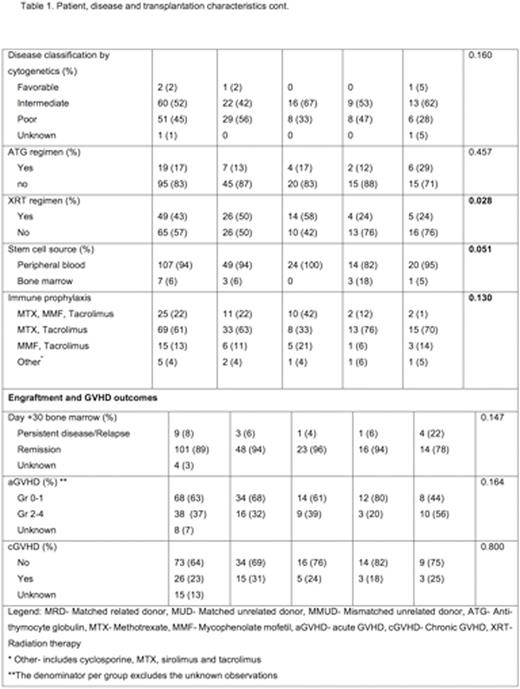Abstract
Introduction:
While 65-70 years is the median age of presentation for AML, outcomes continue to be suboptimal in patients 60 years of age or greater. This population tends to have adverse cytogenetic and molecular profiles while their medical management is often complicated by multiple co-morbidities. There is paucity of literature on the outcomes in AML patients greater than 60 years of age undergoing allogeneic hematopoietic cell transplant (allo-HCT), particularly for patients beyond complete remission 1(CR1).
<> Methods: <> We retrospectively identified all patients at Washington University School of Medicine undergoing allo-HCT for AML between January 2006 and December 2012. Patients were then classified as CR1 or beyond CR1 (>CR1). The primary study endpoint was overall survival (OS). Secondary endpoints included leukemia free survival (LFS), cumulative incidence of relapse and non-relapse mortality (NRM). Patient, disease and treatment-related variables for the study groups were compared using the chi-square statistic or Fishers Exact test for categorical variables and the Kruskal-Wallis test for continuous variables. Cumulative incidence plots were generated by SAS macro %CIF and Gray's test was utilized to test equality of cumulative incidence function between study groups. Kaplan-Meier (KM) curves for OS were generated and provide unadjusted survival estimates between study groups. Differences between study groups were determined by log-rank tests. Cox proportional hazard model was used in multivariate analysis for OS and LFS. All statistical tests were two-sided using an alpha level of significance of 0.05. SAS Version 9.3 (Cary, NC) was used to perform all statistical analyses.
Results:
We identified 114 patients who met inclusion criteria. The patient characteristics are described in Table 1. Of these, 62 patients were beyond CR1 (24 in CR2, 17 with persistent cytogenetic abnormalities (CP) and 21 with active disease). The remaining 52 patients transplanted in CR1 were included as a control cohort. Patient characteristics in the two cohorts are described in Table 1. Three-year OS was 35.0% (95% CI 22-48) for individuals transplanted in CR1, while it was 26.6% (95% CI 16-38) in >CR1 (p=0.0504, Figure 1a). Relapse Incidence (RI) at 3-years was 43.3% (95% CI 29-57) in CR1, and 50.8% (95% CI 37-63) in >CR1 (Figure 1b). Three-year NRM in CR1 was 27.2% (95% CI 16-40) and 24.7% (95% CI 15-36) in >CR1 (Figure 1c). aGVHD (acute graft versus host disease) at 3-years of follow up in CR1 group was 50.9% (95% CI 36-64) and 41.0% (95% CI 28-53) in >CR1. cGVHD (chronic graft versus host disease) in CR1 group at 3-years of follow up was 23.8% (95% CI 13-36) and 10.6% (95% CI 4-20) in >CR1. On multivariate analysis, active disease at the time of transplant was associated with poor OS (p<0.05) (HR 3.648; CI 1.980-6.720) and poor LFS (p<0.01) (HR 3.058; CI 1.708-5.477).
Conclusions:
Given these findings, allo-HCT is a viable treatment option with acceptable long-term survival in AML patients 60 years of age or greater. Overall, there is a trend towards worse survival in patients transplanted beyond CR1. Specifically, active disease at transplant is associated with poor outcomes. These results underscore an unmet need to develop novel protocols associated with improved survival in these patients.
DiPersio:Incyte Corporation: Research Funding. Schroeder:Incyte Corporation: Honoraria, Research Funding.
Author notes
Asterisk with author names denotes non-ASH members.




This feature is available to Subscribers Only
Sign In or Create an Account Close Modal